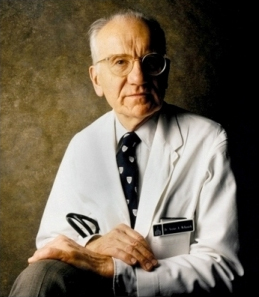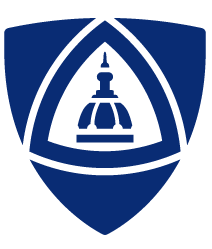
The Johns Hopkins University is a private research university in Baltimore, Maryland, US. Founded in 1876, the university was named for its first benefactor, the American entrepreneur and philanthropist Johns Hopkins.

The Johns Hopkins Hospital (JHH) is the teaching hospital and biomedical research facility of the Johns Hopkins School of Medicine, located in Baltimore, Maryland, U.S. It was founded in 1889 using money from a bequest of over $7 million by city merchant, banker/financier, civic leader and philanthropist Johns Hopkins (1795–1873). Johns Hopkins Hospital and its school of medicine are considered to be the founding institutions of modern American medicine and the birthplace of numerous famous medical traditions including rounds, residents and house staff. Many medical specialties were formed at the hospital including neurosurgery, by Harvey Cushing and Walter Dandy; cardiac surgery by Alfred Blalock; and child psychiatry, by Leo Kanner. Attached to the hospital is the Johns Hopkins Children’s Center which serves infants, children, teens, and young adults aged 0–21.
Medical tourism refers to people traveling abroad to obtain medical treatment. In the past, this usually referred to those who traveled from less-developed countries to major medical centers in highly developed countries for treatment unavailable at home. However, in recent years it may equally refer to those from developed countries who travel to developing countries for lower-priced medical treatments. The motivation may be also for medical services unavailable or non-licensed in the home country: There are differences between the medical agencies world-wide, whether a drug is approved in their country or not. Even within Europe, although therapy protocols might be approved by the European Medical Agency (EMA), several countries have their own review organizations in order to evaluate whether the same therapy protocol would be "cost-effective", so that patients face differences in the therapy protocols, particularly in the access of these drugs, which might be partially explained by the financial strength of the particular Health System.

Victor Almon McKusick was an American internist and medical geneticist, and Professor of Medicine at the Johns Hopkins Hospital, Baltimore. He was a proponent of the mapping of the human genome due to its use for studying congenital diseases. He is well known for his studies of the Amish. He was the original author and, until his death, remained chief editor of Mendelian Inheritance in Man (MIM) and its online counterpart Online Mendelian Inheritance in Man (OMIM). He is widely known as the "father of medical genetics".

The Johns Hopkins Bloomberg School of Public Health (JHSPH) is part of Johns Hopkins University in Baltimore, Maryland, United States. As the first independent, degree-granting institution for research in epidemiology and training in public health, and the largest public health training facility in the United States, the Bloomberg School is a leading international authority on the improvement of health and prevention of disease and disability. The school's mission is to protect populations from illness and injury by pioneering new research, deploying its knowledge and expertise in the field, and training scientists and practitioners in the global defense of human life. The school is ranked first in public health in the U.S. News and World Report rankings and has held that ranking since 1994.

The Johns Hopkins University School of Medicine (JHUSOM), located in Baltimore, Maryland, is the research-intensive medical school of Johns Hopkins University. Founded in 1893, the School of Medicine shares a campus with the Johns Hopkins Hospital and Johns Hopkins Children's Center, established in 1889. Johns Hopkins has consistently ranked among the top medical schools in the United States, in terms of the number of research grants awarded by the National Institutes of Health, among other measures.

John Shaw Billings was an American librarian, building designer, and surgeon. However, he is best known as the modernizer of the Library of the Surgeon General's Office of the Army. His work with Andrew Carnegie led to the development and his service as the first director of the New York Public Library. Billings oversaw the building of the Surgeon General's Library, which was the nation's first comprehensive library for medicine. Because of his approach to improving public health and hospitals, Billings headed the U.S. Census Office's division of Vital Statistics and oversaw statistical compilation of censuses. With Robert Fletcher, Billings developed Index Medicus, a monthly guide to contemporary medicine that ran for 16 months until his retirement at the Medical Museum and Library. At the latter end of his work with the military, Billings aided the United States' Secretary of the Treasury in adjusting the organization of the military hospitals. With his growing credibility in the medical field, Billings also oversaw work done to aid those struggling with yellow fever. He also served as Johns Hopkins Hospital's medical advisor, authored reports regarding criteria for medical and nursing curricula, and hospital design. Although his name is not included in the infamous "Big Four" at Hopkins, Billings made major contributions, by the means of the Johns Hopkins Hospital's architecture, infrastructure, and curriculum for the Johns Hopkins School of Medicine.

William Henry Welch was an American physician, pathologist, bacteriologist, and medical school administrator. He was one of the "Big Four" founding professors at the Johns Hopkins Hospital. He was the first dean of the Johns Hopkins School of Medicine and was also the founder of the Johns Hopkins School of Hygiene and Public Health, the first school of public health in the country. Welch was more known for his cogent summations of current scientific work, than his own scientific research. The Johns Hopkins medical school library is also named after Welch. In his lifetime, he was called the "Dean of American Medicine" and received various awards and honors throughout his lifetime, and posthumously.

Max Brödel was a medical illustrator. Born in Leipzig, Germany, he began his artistic career after graduating from the Leipzig Academy of Fine Arts, working for Dr. Carl Ludwig. Under Ludwig's instruction, Brödel gained a basic knowledge of medicine and became recognized for his detailed medical illustrations. In the late 1890s, he was brought to the Johns Hopkins School of Medicine in Baltimore to illustrate for Harvey Cushing, William Halsted, Howard Kelly, and other notable clinicians. In addition to being a prolific medical illustrator, he developed new artistic techniques such as the carbon dust technique that helped the advancement of the quality and accuracy of medical illustrations for physicians. In 1911, he presided over the creation of the first Department of Art as Applied to Medicine; located at the Johns Hopkins School of Medicine, it continues to train medical illustrators to this day. His graduates spread out across the world, and have founded a number of other academic programs.

Johns Hopkins Bayview Medical Center is teaching hospital trauma center, neonatal intensive care unit, geriatrics center, and is home to the Johns Hopkins Burn Center, the only adult burn trauma in Maryland, containing about 420 beds. Located in southeast Baltimore City, Maryland, along Eastern Avenue near Bayview Boulevard, it is part of the Johns Hopkins Health System and named after its close proximity to the Chesapeake Bay. Founded in 1773 as an almshouse, it was relocated several times until its now present location in 1866. In 1925, it transitioned into several municipal hospitals, which transferred ownership to Johns Hopkins Hospital in 1984.

Peter J. Pronovost is Chief Clinical Transformation Officer at University Hospitals Cleveland Medical Center and Case Western Reserve University School of Medicine. At UH, Pronovost is responsible for improving value across the health system, helping people stay well, get well and manage their most acute medical conditions. He is the clinical lead for population health and the lead for high-reliability medicine, with direct responsibility for the UH employee accountable care organization. He is also responsible for telehealth and virtual health programs serving patient and provider communities.

Tourism in Costa Rica has been one of the fastest growing economic sectors of the country and by 1995 became the largest foreign exchange earner. Since 1999, tourism has earned more foreign exchange than bananas, pineapples and coffee exports combined. The tourism boom began in 1987, with the number of visitors up from 329,000 in 1988, through 1.03 million in 1999, over 2 million in 2008, to a historical record of 2.66 million foreign visitors in 2015. In 2012, tourism contributed with 12.5% of the country's GDP and it was responsible for 11.7% of direct and indirect employment. In 2009, tourism attracted 17% of foreign direct investment inflows, and 13% in average between 2000 and 2009. In 2010, the tourism industry was responsible for 21.2% of foreign exchange generated by all exports. According to a 2007 report by ECLAC, tourism contributed to a reduction in poverty of 3% in the country.
Medical centers in the United States are conglomerations of health care facilities including hospitals and research facilities that also either include or are closely affiliated with a medical school. Although the term medical center is sometimes loosely used to refer to any concentration of health care providers including local clinics and individual hospital buildings, the term academic medical center more specifically refers to larger facilities or groups of facilities that include a full spectrum of health services, medical education, and medical research.

John Whitridge Williams was a pioneering obstetrician at Johns Hopkins Hospital. Williams was also an acclaimed author, as he was able to contribute 137 publications regarding his findings.
Johns Hopkins Medicine International (JHMI), not to be confused with Johns Hopkins Medical Institute, also (JHMI), is a partnership program established by the Johns Hopkins School of Medicine to raise the standard of health care through long-term, mission-driven agreements.

Clemenceau Medical Center (CMC) Beirut is a medical center affiliated with Johns Hopkins Medicine International located in Beirut, Lebanon. The 158 bed hospital houses all the specialty branches, including Neurology, General Surgery, Pulmonary, Cardiac Center, Urology, OB/GYN, Fertility & IVF Center, Digestive Disease & Colonoscopy Center, Diagnostic Services, Robotic Surgery, full-fledged Cancer Center with Radiation Oncology Department, etc.
Timothy Danforth Baker was a professor of international health at the Johns Hopkins Bloomberg School of Public Health. He was also one of the founders of the study of international health.

Johns Hopkins Children's Center (JHCC) is a nationally ranked, pediatric acute care children's teaching hospital located in Baltimore, Maryland, adjacent to Johns Hopkins Hospital. The hospital has 196 pediatric beds and is affiliated the Johns Hopkins School of Medicine. The hospital is the flagship pediatric member of Johns Hopkins Medicine and is 1 of 2 children's hospital in the network. The hospital provides comprehensive pediatric specialties and subspecialties to infants, children, teens, and young adults aged 0–21 throughout Baltimore and the wider United States. Johns Hopkins Children's Center also sometimes treats adults that require pediatric care. Johns Hopkins Children's Center also features one of the only ACS verified Level 1 Pediatric Trauma Centers in the state. The hospital is directly attached to Johns Hopkins Hospital and is situated near the Ronald McDonald House of Maryland.













